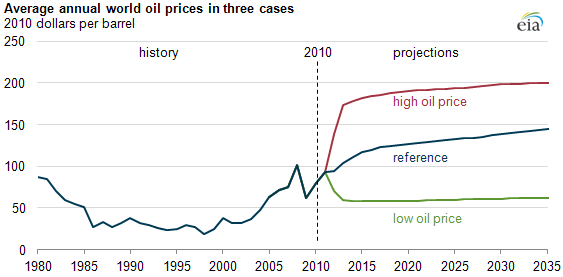
AEO2012 considers three cases for the future of world oil prices

Note: "Petroleum" refers to crude oil (including tight/shale oil), lease condensates, natural gas plant liquids, and refinery gain. "Other liquids" refers to biofuels, bitumen (oil sands), coal-to-liquids, biomass-to-liquids, gas-to-liquids, extra-heavy oils, and oil shale.
Download CSV Data
The Annual Energy Outlook 2012 (AEO2012) presents three alternative paths for world oil prices based on different production and economic assumptions. Among these cases, the real (constant 2010 dollars) oil price in 2035 ranges from $62 per barrel in the Low Oil Price case to $200 per barrel in the High Oil Price case, with the Reference case at $145 per barrel.
The oil price in AEO2012 is defined as the average price of light, low-sulfur crude oil delivered to Cushing, Oklahoma, which is similar to the price for light, sweet crude oil traded on the New York Mercantile Exchange (West Texas Intermediate, or WTI).
Factors considered in AEO2012 that affect supply, demand, and prices for petroleum in the long term are:
- World demand for petroleum and other liquids
- Organization of the Petroleum Exporting Countries (OPEC) investment and production decisions
- The economics of non-OPEC petroleum supply
- The economics of other liquids supply
The Reference case of AEO2012 indicates a short-term increase in oil price, returning to price parity with the Brent oil price by 2016, as current constraints on pipeline capacity between Cushing and the Gulf of Mexico are moderated.
The Low Oil Price case results in a projected oil price of $62 per barrel in 2035. The Low Oil Price case assumes that economic growth and demand for petroleum and other liquids in developing economies (which account for nearly all of the projected growth in world oil consumption in the Reference case) is reduced. Specifically, the annual gross domestic product (GDP) growth for the world, excluding the mature market economies that are members of the Organization for Economic Cooperation and Development (OECD), is assumed to be 1.5 percentage points lower than that of the Reference case in 2035 (only a 3.5% annual increase from 2010 to 2035), which reduces their projected oil consumption in 2035 by 8 million barrels from the Reference case projection. While non-OECD oil consumption is more responsive to lower economic growth than to prices, oil use in the OECD region increases modestly in the Low Oil Price case. In this lower price case, the market power of OPEC producers is weakened, and they lose the ability to control prices and to limit production.
In contrast, the High Oil Price case assumes prices rise to $186 per barrel by 2017 (in 2010 dollars) and then increase to $200 per barrel by 2035. These higher prices result from higher demand for petroleum and other liquid fuels in non-OECD regions than projected for the Reference case. In particular, the projected GDP growth rates for China and India are 1.0 percentage point higher in 2012 and 0.3 points higher in 2035 than the rates in the Reference Case. Overall, in 2035 it is projected that 4 million barrels per day will be produced above the Reference Case level, even though projected oil consumption in the mature, industrialized economies is reduced.